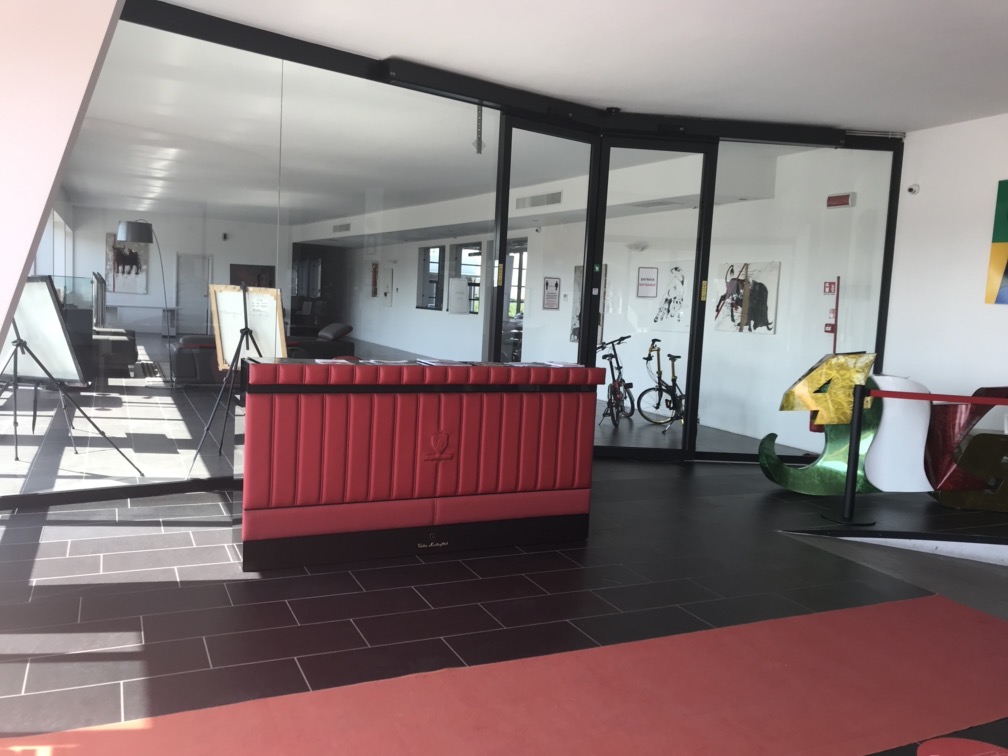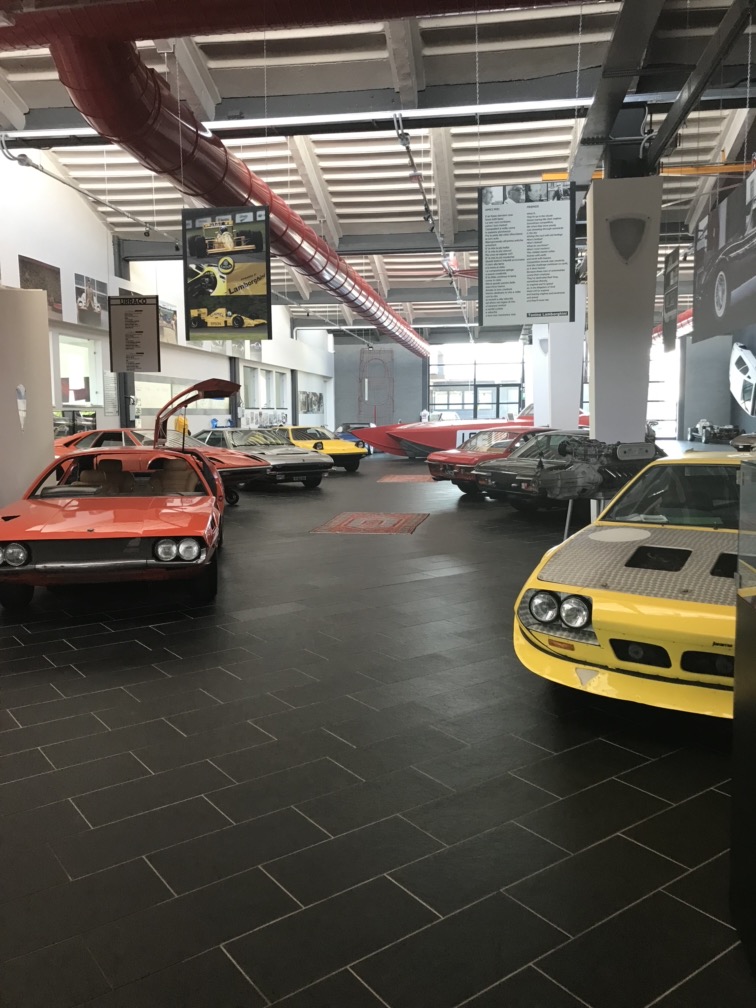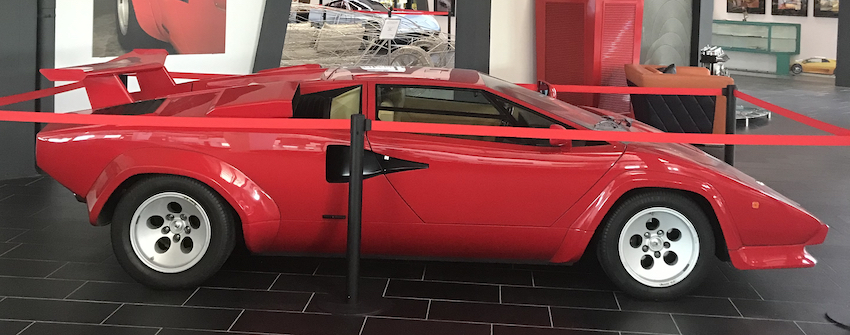

My Favorites
Many rare or even unique cars retrace the industrial adventure of Ferruccio Lamborghini and the history of the brand under his direction. Here are my favorites in this visit:
- The 350 GTV, Lamborghini’s first and a true manifesto for the new brand
- The Off-shore racing boat
- Prototypes that help understand the genesis of production cars
- The Espada, I’m a big fan of this car
Ferruccio Lamborghini
Passionate about mechanics, Ferruccio Lamborghini graduated in 1939 and was mobilized in the Italian army. Taken prisoner by the English on the island of Rhodes, he became a mechanic in charge of the island’s fleet of vehicles and he became familiar with the machines used by the army. After the war, he opened a small garage and began to transform military equipment abandoned by the Allies into agricultural tractors. In 1947, he had the opportunity to buy a large stock of equipment, including English Morris engines that he knew well from having worked on them during the war. This is how he created the Carioca, his first tractor badged Lamborghini but which remains mainly an assembly of recovered parts. In 1951, it was the first Lamborghini production tractor, only the engine still being the Morris. Then came the first Lamborghini engines, even if we are still far from the powerful V12. In about ten years, Lamborghini becomes the 3rd Italian manufacturer of agricultural tractors. At the end of the 1940s, he also engaged in motor racing with small Fiat-based barchettas, but the activity stopped quickly after an accident in 1948.

The Ferruccio Lamborghini Museum
Located north of Bologna in the Emilia-Romagna region, the Ferruccio Lamborghini Museum is about 25 km from the Lamborghini headquarter of San'Agata Bolognese. Created in 2014 by Tonino Lamborghini, son of Ferruccio, it pays tribute to the engineer and the entrepreneur through his various creations, not only the cars of the eponymous brand. While the museum mainly covers the period when Ferruccio Lamborghini was involved, from the late 1940s to the 1970s, it also covers the brand's activities until the takeover by Audi in 1998. On the other hand, the museum is also interested in Lamborghini's other industrial productions, beyond cars. A large low building, decorated with some Lamborghini silhouettes, welcomes you. Huge parking, so no parking worries. The museum is spread over 9000 m², in vast thematic halls. Bright, airy, the industrial style given by the painted pipes of the ceiling contrasts with the large carpets and armchairs that give the place a comfortable atmosphere. It is easy to go around the cars that can be approached as close as possible. There is no imposed visit route, and you can easily return to your favorite area. For this tour, we will walk through the museum following both chronological and thematic order, starting with the cars.

The creation of Automobili Lamborghini
Fortune made with its industrial activity, Ferruccio indulged himself sports cars, including Ferraris. The story that will lead to the creation of the car brand has often been told. Ferruccio Lamborghini was driving a Ferrari 250 GTE and had recurring clutch problems. So he fitted a clutch used on some of his tractors, which he had found to be similar to that of the Ferrari, and everything returned to normal. He told Enzo Ferrari about it and offered him a partnership to improve the reliability of Ferraris. Upset, Enzo advised him to return to his tractors instead of wanting to drive the best of the automobile: “Lamborghini, you may be able to drive a tractor, but you will never know how to drive a Ferrari properly” according to Ferruccio Lamborghini. The remark obviously did not please Ferruccio Lamborghini, who then decided to build his own cars and challenge Ferrari on his turf. The company “Automobili Ferruccio Lamborghini” was created in July 1963, located between Modena and Bologna, to benefit from the pool of engineers available in this region, already at that time. Ferruccio Lamborghini chose as his emblem a bull in an attacking position, head down. Bull was his astrological sign, he readily identifies with the go-getter side of the animal, and looked a perfect opposite of Ferrari’s Prancing Horse.


The Lamborghini 350 GTV was presented a few months later at the Turin Motor Show. If the car made a strong impression by its innovative side and its performance, the brand is unknown and the car will remain unique. Lamborghini returned in 1964 with the 350 GT, an elegant Grand Touring, more classic in some aspects, which will be the first production of the brand, still with the 3.5L V12, developing 280 horsepower. The model will then evolve into 400 GT, larger (2+2) and more powerful. But it was especially with the Miura presented in 1966 that Lamborghini revolutionized the sports car market. The Miura is often considered the first supercar. Other more classic models, still designed by Bertone, complete the brand’s offer.
Lamborghini’s last major work under Ferruccio’s direction will be the Countach, another thunderbolt in the world of super sports cars. Presented in 1971, the Countach went into production in 1974. The oil crisis of 1973 put Lamborghini in great difficulty, and Ferruccio Lamborghini sold his companies and retired. The firm will then know a rather chaotic existence, until the takeover by Audi in 1998.
Ferruccio’s Lamborghini
Once past the reception, we enter the vast hall: on the left the cars, on the right the tractors, and in front of the passage to an arch that leads to the origins of the brand, between a Miura and a Countach to which we will get back. The 350 GTV (Gran Turismo Veloce) is presented under a large portrait of Ferruccio Lamborghini. The body, characterized by its curved windshield with a single wiper and tilting streamlined headlights, was designed by Franco Scaglione.
A unit of the 3.5L V12 for 350 horsepower, developed in-house, sits next to the car; it is the work of Giotto Bizzarrini, engine designer of the legendary Ferrari 250 GTO. For Ferruccio Lamborghini, a homemade V12 is imperative to counter Ferrari, no question of looking for a powerful V8 elsewhere. The chassis was designed by Gian Paolo Dallara, a young engineer from Maserati who would later become famous with his own company, creating many racing cars, including Formula 1. 2 copies are created, a body without engine to be exhibited in shows and this car that will be Ferrucio’s personal car.


Next to it, there is the Ferrari 250 GTE at the origin of the whole adventure, and a 400 GT 2+2. The 400 GT succeeded the 350 GT in 1966, with its V12 increased to 4L and 320 hp. The 400 GT 2+2 on display features a modified body offering more space and comfort to passengers, in a more Grand Touring spirit. Let’s go back a little to the reception, for 2 other cars surrounded by ropes, a Miura SV and a Countach, 2 other unique cars since they were Ferruccio Lamborghini’s personal cars (which explains the protections). In this regard, we can just regret that the cars were not rather installed on small platforms, to avoid these ropes that cut the view.
With the 350 hp V12 in the central position, as on the racing prototypes, and a pure, very low line designed by Marcello Gandini for Bertone, the Miura is unlike any other sports car on the market. The Miura also marks the beginning of a long cooperation between Lamborghini and Bertone, which will give birth to several automotive masterpieces. This Lamborghini/Bertone partnership also comes in opposition to the Ferrari/Pininifarina duo. Finally, it is the first to bear the name of a famous bull, a tradition that will then be perpetuated for many models. The Miura on display is an SV version, the ultimate version of the Miura, more powerful (385 hp) and supposed ride up to 300 km/h.



Next to this Miura, an aluminum body is the reconstruction of a Jota. Despite producing very sporty cars, Ferruccio Lamborghini did not want to get involved in motor racing, seeing it as the risk of a financial abyss. Bob Wallace, the engineer in charge of testing the Miura, still managed to convince Ferruccio to entrust him with a car that he wanted to lighten and equip with a more powerful engine. Unofficial, the project took time to realize and the single car was unfortunately destroyed in an accident. This Jota is therefore a kind of sculpture made according to the original plans
With the Countach, a new era opens in style. The Miura has soft, curved lines, while the Countach is all angles. Ferruccio Lamborghini and Marcello Gandini wanted something radically different, and it can be said that the result met their expectations with a car again very innovative compared to the rest of the (small) production of this category of cars. The Countach will define the direction of Lamborghini style to the present day. We will find the doors with opening in elytra, the angular and aggressive line on many Lamborghini until today. The model exhibited at the museum has the enlarged body at the wheel arches, the large rear spoiler and the front spoiler that reinforce the aggressiveness of the line.

Production Lamborghinis
After the reception, the hall on the left is dedicated to Lamborghini production cars. For the car lover, this is certainly the heart of the museum. Production of most Lamborghini models from this period was limited or very low. So the cars exhibited are rare, sometimes unique, and many visitors will discover them for the 1st time. The 400 GT was an estimable success for the time, especially in its 2+2 version with about 400 cars built. The Islero succeeded it in 1968, with a more modern line taking some of the style codes of the 350 GTV. It is an elegant GT 2+2 still equipped with the house V12 developing from 320 to 350 hp depending on the version, respectable power for the late 1960s. But its somewhat light finish will earn it a short career (barely 2 years for about 225 copies) despite the progress of the GTS version.



La Jarama succeeded it in 1970. Classic line for a GT 2+2, V12 from 350 to 365 hp, but it will be only a little more commercially successful (about 300 ex). Next to the production Jaramas, a Jarama SVR, a unique competition version developed by Bob Wallace, is on display: modified and lightened body with many aluminum panels, optimized engine, stripped interior… But this SVR remained a beautiful exercise in style. Despite their elegance and performance, enthusiasts finally expect Lamborghini to be more daring and original in the lines.



It must also be said that there is at the same time in the Lamborghini range the Espada presented in 1968 that comes out of the classic. Its low, slender line is one of Marcello Gandini’s other masterpieces, with its double rear window and large doors opening onto a luminous cabin and 4 seats. Powerful with its traditional V12 4L of 325hp then 350hp, capable of taking 4 people and their luggage at nearly 250 km/h, the Espada is unique by its elegance, originality and performance. It will be produced in more than 1200 units in about ten years. Its name does not come from a bull, but means “sword” in Spanish, a reference to the matador’s sword. In addition to 2 Espadas series, including a magnificent one in dark blue, the museum also exhibits one of the first prototypes that kept the idea of 2 large “butterfly” doors, as on the original Marzal concept car. Curiously, this prototype is a right-hand drive. The production version will return to a more conventional opening, but this wide-open prototype allows for a better appreciation of the Espada’s interior space. In the background, another presentation shows an “exploded” Espada , engine chassis and suspensions on the ground, while the body is on the wall.





The Lamborghini Urraco was presented in 1970, but did not come to production until 1972, delayed by the oil crisis. Also designed by Marcello Gandini, the Urraco is a 4-seater coupe (well, rather 2+2) with a mid-engine. The more compact 2.5L V8 allows this configuration, and Lamborghini expands its offer with a less expensive model. The Urraco should allow Lamborghini to come and hunt on the land of the Porsche 911 and Ferrari Dino. Lamborghini will also develop an Urraco 2000 version, the V8 being reduced to 2L to satisfy the Italian market, the authorities having at one time heavily taxed cars equipped with engines of more than 2L of displacement. Ferrari and Maserati will also carry out the same approach at this time. A prototype body showed one of Bertone’s proposals for the Urraco, which was turned down by Ferruccio Lamborghini. The silhouette may remind you of another Italian model. Indeed, amusing anecdote, this refused proposal will serve as a basis for the Ferrari 308 which was to replace the Dino and that Ferrari had entrusted to Bertone. The approach was common among bodybuilders who often recycled their concepts or drawings rejected on projects of other manufacturers.



The yellow Urraco prototype is based on an Urraco P300, and was used to study different chassis concepts, which was to lead to a new model called Silhouette (not exhibited here), which was not very successful, and became the Jalpa. The Jalpa uses the chassis and engine of the Urraco, but in a 2-seater configuration. Produced in a difficult period for the Lamborghini firm, and lacking elegance (personal opinion), the Jalpa will know a limited success. The museum exhibits a unique prototype of spyder targa based on Jalpa that will be exhibited at several fairs but never produced.
In this same hall, the surprise is an impressive off-shore racing boat. With its 13.50 meters, it far exceeds all cars produced by Lamborghini. It is powered by 2 V12 engines of 8L displacement, delivering nearly 800 hp each. Derived from the block used in the LM-002 (see below), this engine was developed specifically for racing boats. If this boat dates from 1992, it recalls that Lamborghini raced for many years in offshore racing, winning a great harvest of victories and championships. He also recalls that the Lamborghini 3.5L V12 has also been used in touring boats (luxury and sporty). Ferruccio Lamborghini had even equipped a Riva Aquarama boat with 2 V12s for his personal use. A model of the boat, a photo and the engine illustrate this association, with a Lamborghini 350 GT in the background that beautifully completes this high-performance family. Several engines accompany the cars, which makes it possible to admire the mechanical jewel more closely. Photos and plans decorate this room.



There are also some Lamborghini models produced after the sale of the company by Ferruccio Lamborghini: a Diablo, model that will succeed the Countach, and an LM-002, or more precisely the steel structure of this SUV before the time. Indeed, the LM-002 was the first 4×4 grand tourer, luxurious and sporty despite its 2.7T. It is still a V12 that officiates in the engine room, propelling the machine to more than 200 km/h. its gargantuan consumption and the company’s difficulties in the early 1980s limited its commercial success, but the LM-002 paved the way for machines such as the Hummer in a “civilian” version.


The central part
Returning to the central part of the building, we find an evocation of Lamborghini’s participation in Formula 1. If Ferruccio Lamborghini had always been reluctant to enter competition, Lamborghini, then controlled by Chrysler, will make a short foray into F1. Lamborghini will be mainly engine manufacturer with obviously a V12 of 3.5L, but also chassis manufacturer in the 1991 season. The results will be averaged, with a 7th place for the Lambo 291 in 1991 (US GP), and a podium for Aguri Suzuki on Larrousse at the 1990 Japanese GP. Some photos and a copy of the V12 testify to this sporting adventure. Opposite is a reproduction of Ferruccio Lamborghini’s office.


The beginning and industrial history
I chose to start with the cars, but the visit can also start from the right of the hall and dive back into the beginnings of Ferruccio Lamborghini and its industrial history. There are in particular 2 small “barchettas” with which Ferruccio tried his hand at competition. In parallel with his still artisanal activity of building agricultural tractors, he modified and built some racing cars on Fiat bases, like many Italian enthusiasts at that time. The museum preserves a car developed in 1946 and signed on its front hood, as well as the tray modified to run the 1948 Mille Miles. It is also branded Lamborghini, in a font that will be found many years later on production cars. The car has been thoroughly reworked, both in terms of its structure and engine. Displacement increased to 650 cc, lighter parts, higher engine speed, improved carburation, we find the classic ingredients of preparation for these small cars. As mentioned above, an accident will put an end to the pilot’s career, especially since the development of tractors production required more attention.


We find in this hall the story of this first industrial adventure that will make Lamborghini the 3rd Italian tractors manufacturer and a renowned brand. Not being an expert in tractors, I will not dwell too much on this part of the museum, however very interesting in more ways than one. We see the progression from assembling existing elements to complete design in-house. The finish progresses, the size also little by little, even if we remain far from the current monsters in comparison. It also seems that Lamborghini has produced many models of small tractors. Next to each model, a common contemporary equipment (typewriter, record player …) allows the visitor to position the model in its time.




A unique model catches the eye, a 2R tractor modified by Mr. Adler Capelli in 2016 for the centenary of the birth of Ferruccio Lamborghini. Unpainted raw body, low-loaded, converted suspensions, this tractor almost looks like a hot-rod. Even more surprising, a Lamborghini helicopter: in the early 1960s, Ferruccio Lamborghini developed a prototype helicopter for which he wanted support from the Italian government. A prototype is built, including the engine, but the support does not come, the project will be abandoned. The style of the machine is very special, with a very innovative structure and architecture for the time. Next to the helicopter, some industrial burners are on display: this is probably not the most exciting part of the museum, but it was an important and lucrative activity for the group, as well as the refrigeration blocks that will be seen on the other side of the hall separation wall. In any case, they show the diversity of the Lamborghini group’s industrial activities and the dynamism of its founder.
Family cars
In this wing of the 2nd part of the museum is the car collection of the Lamborghini family. We pass in front of a curious Fiat Balila 2 doors, transformed with a gasifier during the war to compensate for the lack of fuel. Next to an old Fiat Balila from the 1930s, the car exhibition allows you to follow the evolution of the success of the entrepreneur Ferruccio Lamborghini. After the Fiat Topolino and Fiat 1400, the family drove Alfa Romeo, Mercedes, Ford Mustang or Porsche. Ferruccio Lamborghini will also own Lancia, Jaguar E-Type, Maserati and of course Ferrari.



Among the models, we can distinguish, a Fiat Topolino Type C of 1952, customized and which was the car of the second wife of Ferruccio Lamborghini, an Alfa Romeo 1900 Super two-color, his last of this model (he had 4) and a Ford Mustang 1st generation. We also discover several 2 wheels, bicycles, mopeds, scooters, motorcycles, a small motor car built for his son Tonino in 1955, as well as other tractors and caterpillars.





At the other end of the hall are Tonino Lamborghini’s cars. Ferruccio’s son is an entrepreneur who has developed many activities (textiles, perfumes, jewelry, watches, luggage…) and also electric city and golf carts of which we can see some units. In addition to 2 Rolls Royce, there is a Puma GTV, a handcrafted coupe built in Italy on an English base (Nova), and which is characterized by its particular on board access: the windscreen, roof and doors constitute a unique piece that tilts forward. Even more curious, a largely customized AMG coupe, which we will let everyone appreciate the style… Spectacular. On the walls, many photos and posters of cars, factories and personalities linked to the brand tell the story. Some furniture, mannequins and objects complete this sober decoration.




Conclusion
As mentioned earlier, the Ferruccio Lamborghini Museum is mainly devoted to the work of the “Ingegnere”, as he was often called (also in reference to the “Commendatore” Enzo Ferrari), in its various industrial aspects. However, many exhibits make the link between the sale of the company by its creator and the takeover by Audi, which will bring stability and a second life to the manufacturer, clearly avoiding its disappearance. Thus, the “official” Lamborghini Museum of Sant’Agata Bolognese will complete the story, although it also offers some models from the initial period. For us car lovers, there are real treasures to discover, several unique cars, prototypes that help understand the genesis of certain models. Discovering the other facets of the character and his other activities is also very interesting.
The photos on this page belong to Automobile-Museums, no use or reproduction is allowed without the prior written consent of the owner.
Museums are living places, and therefore the content or layout may have changed between the publication of this article and your visit. The layout may be different, cars may be absent (overhaul, maintenance, loan …) and new ones were able to join the exhibition.
